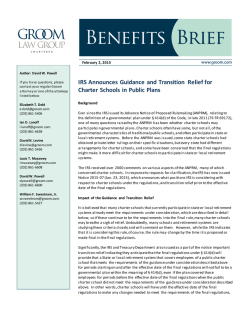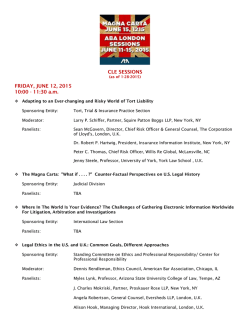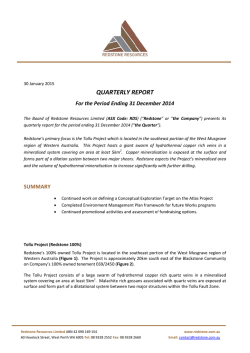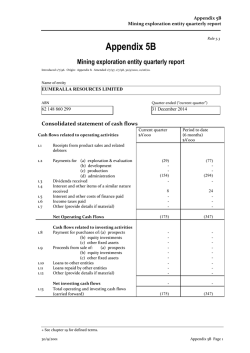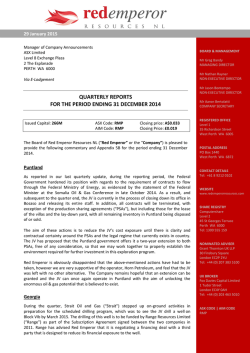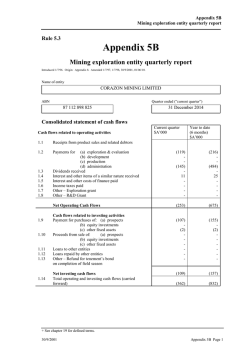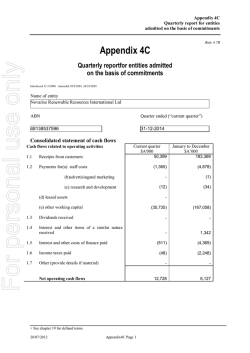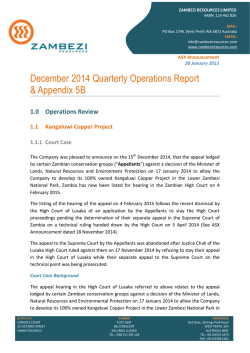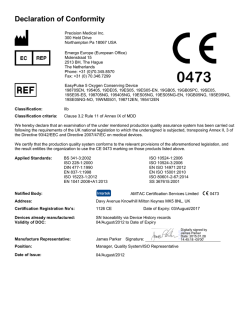
The Legal Entity Identifier Regulatory Oversight Committee
LEI ROC 29 January 2015 An Open Document to Support the Implementation of the ROC “Principles to be Observed by Pre-LOUs that Wish to Integrate into the Interim Global Entity Identifier System (GLEIS)” This document reflects the views of the ROC Committee on Evaluation and Standards (CES), not necessarily the official views of the ROC or its requirements for pre-LOUs. It is intended to be an open and evolving framework for providing guidance to pre-LOUs in complying with the principles and requirements contained in “Principles to be observed by Pre-LOUs that wish to integrate into the Interim Global Legal Entity Identifier System (GLEIS)1” (PLP). The sections below address (1) further specification of the fields of the ISO 17442: 2012 standard, (2) validation standards, (3) survival rules under exclusivity violations, and (4) portability and history. The text is largely organized as a set of questions and answers to emphasize the openness of the document. Although some of the material here further specifies official ROC requirements in the PLP, much of the guidance is intended to describe what is currently seen by the CES as best practices in light of a variety of earlier interactions with the PSPG, the ISO SAG for ISO 17442 and others. Sometimes this intent is signaled directly in the text by the use of the term “best practice” but other times is it is signaled more indirectly by the use of the work “should.” In no case should the pursuit of a best practice slow the adoption of the most critical elements of the interim GLEIS: free and clear communication of information to the public including provision of the LEI records using the Common Data Format, adoption of common standards for the content of the reference data field defined by ISO 17442: 2012, application of appropriate validation procedures to support high data quality, and fulfillment of requests to port the maintenance of reference data across pre-LOUs. As experience is gained, either through further discussions or through early attempts to implement the best practices, the guidance given here may also evolve. Other questions and answers may be added in response to the needs of various stakeholders. This Q&A has been developed to provide a vehicle for communicating the current work and thinking of the CES as informed by the PSPG, the pre-LOUs, ROC members, and other participants in the development of the GLEIS. 1 http://www.leiroc.org/publications/gls/lou_20130727.pdf [email protected] www.leiroc.org Page 1 of 24 I. Further specification of the fields of the ISO17442: 2012 standard2 The reference data fields required under the ISO 17442 standard include the following: (1) the official name of the entity; (2) where applicable, the name of the business registry in which the entity was formed and the identification number of the entity within the register; (3) the headquarters address or address of the fund manager; (4) the legal address of the entity; (5) the date the LEI was first assigned; (6) the date of last update of the LEI information; and (7) where applicable, the date of expiry, the reason for expiry, and where applicable the LEI of the successor entity or entities. Each of the seven data elements is addressed in turn below. An additional section provides a brief overview of other potential attributes, their use and an indication of their priority for future discussion. In some cases, encompassing funds within the ISO standard requires specific additional guidance. If other entity structures are discovered to present similar problems, their treatment can be expected to be incorporated in a similarly principled way. The Common Data File Format provides a framework for reporting information in the GLEIS. 3 That document provides specific and authoritative instructions on how the elements of the ISO 17442 specification should be reported; it also defines additional data elements important for the interpretation or administration of the GLEIS. Some supplemental guidance for that document is given in this section. In no case, should the guidance given in this document be read as being in conflict with the Common Data Format. I.1 The official name of the entity ISO 17442 specification The official name of the legal entity as recorded in the business registry, or with the fund manager for collective investment vehicles, or otherwise in the entity’s constituting documents. 1.1.a. What constitutes the official name of an entity? Pre-LOUs should record the official name(s) of an entity in the language and character set(s) used in the most basic foundational documents of the entity. In the Common Data Format, this information is recorded in the data element LegalName. 2 The recommendations presented in this section benefitted greatly from the input of the ISO Standards Advisory Group (SAG) for ISO 17442: 2012. Also see PLP Section 4.1 and Minimum Requirement 1. 3 Add link to the CDF on www.leiroc.org [email protected] www.leiroc.org Page 2 of 24 I.1.b. What exceptions may be needed in the case of funds or sub-funds? The official name of a fund is the name as set out in the constituting documents of the fund. This can include an alphabetic name, a numeric code or a combination of both. Where a fund cannot be clearly identified with its legal name, as may be the case with some sub-funds and some other types of funds, the Common Data Format allows for including the LEI (preferred) or name of the relevant umbrella fund or fund manager in a separate data element, AssociatedEntity. Where this data element is used, the attribute AssociatedEntityTypeEnum should be set to FUND_FAMILY. Other types of asssociated entities may be defined in the future. Until further notice, no other use of the AssociatedEntity element should be made within the context of the Common Data Format. I.1.b. What should be done if the official name is given in more than one language or character set? Where multiple languages or character sets apply at this level, pre-LOUs should record all such names. In the Common Data Format, such names should be recorded in the data element OtherEntityNames. I.1.c. Should there be a Romanized version of the official name(s)? Pre-LOUs should also include a version or versions of the official name transliterated by the entity into Roman characters, where the entity has a preference. Pre-LOUs should also consider including as a best practice mechanically transliterated names, using a common standard, such as one of various ISO standards for transliteration; such mechanical transliteration may support more efficient detection of exclusivity violations within the GLEIS as well as more effective global search by users. In the Common Data Format, such names should be recorded in the data element OtherEntityNames with an OtherEntityName data type of “PREFERRED_ASCII_TRANSLITERATED_LEGAL” of “AUTO_ASCII_TRANSLITERATED_LEGAL”. A similar practice should be followed for addresses that are defined using non-Roman characters. I.1.d. Should names other than the legal name that are used in business be recorded? Consideration should also be given to including additional names that are commonly used by an entity in the course of its business. In the Common Data Format, such names may be recorded in the data element OtherEntityNames. [email protected] www.leiroc.org Page 3 of 24 I.2. Where applicable, the name of the business registry in which the entity in which the entity was formed and the identification number of the entity within the register ISO 17442 specification Where applicable, the name of the business registry in which the entity was formed and the identifier of the entity in the business registry should be recorded. I.2.a. What is the meaning of “where applicable” here? According to the ISO SAG for ISO 17442, “where applicable” encompasses the absence of legal constraints imposed by the owner of any registry data as well as the existence of such information. To ensure a consistent approach to the completion of all attributes of the ISO standard across all pre-LOUs within the global system, the ROC is currently seeking confirmation that there are no legal impediments within individual business registries to the collection and publication of the business registration name and the business registration number when supplied to pre-LOUs by the legal entity4. All pre-LOUs are required to collect and display relevant business registry entity identification codes when available and when it has been confirmed to the ROC that no legal constraints exists; such information may be added on a flow basis as entities register or recertify their registrations. The Common Data Format contains the data element BusinessRegisterEntityID to contain the relevant business register code for an LEI registrant. The attribute BusinessRegisterEnum is associated with this field to contain a reference to the business register in which the LEI registrant is recorded, if any. To facilitate improved data quality and data management, the ROC developed a code list to cover all currently known business registers;5 currently, use of the code list in the Common Data File Format is required only for business registers included in the ROC list as having agreed formally that they impose no constraints on the redistribution of their identification numbers within the GLEIS and no constraints on their ultimate use,, but it would be best practice to include a code for the business register in all cases where information from the register was used in the validation process, regardless of whether the code for the entity registered can be published. I.2.b. Can there be more than one business registry that is appropriate? 4 5 http://www.leiroc.org/publications/gls/lou_20131103.pdf Post the full code list on KC. [email protected] www.leiroc.org Page 4 of 24 The ISO SAG for ISO 17442 noted that a strict definition of business registry was not intended in the ISO 17442 standard; more than one registry might be listed and other systematic sources (such as tax-based information systems) might also serve the purpose of validating the legal existence of an entity. According to their recommendation, best practice would be for pre-LOUs to allow for the possibility of including more than one source identified as an appropriate registry and the identification numbers from those sources. However, the Common Data Format requires the publication of only one register. Where multiple registers apply, the register reported should be the one that records the most basic legal identity of an entity, or, failing that, the one that is most commonly used in the relevant jurisdiction. I.3. The headquarters address or address of the fund manager ISO 17442 specification The address of the headquarters of the legal entity or the address of the fund manager. I.3.a. For entities aside from funds, how should headquarters be defined? In some circumstances, the physical headquarters address may be precisely defined as a legal term, but in other situations there is no such formally defined alternative. Where no such formal address exists, focusing on communication as an objective would support allowing the registrant to define for itself an address at which it might be contacted most usefully. Following this approach, it is recommended that where there is no legally defined headquarters address, the physical address where the entity prefers to receive routine communication should be recorded. The address information should be recorded in the Common Data Format element HeadquartersAddress. I.3.b. How should headquarters be defined for funds? The treatment of headquarters address for funds should use the following “waterfall” approach: (1) where the fund’s constituting document identifies an address as its headquarters, that address should be used; (2) failing (1), the address of the management company as provided in the constituting documents should be used; (3) failing (1) and (2), the address of legal formation should be repeated. I.3.c. What other standardization is appropriate for specifying the headquarters address? [email protected] www.leiroc.org Page 5 of 24 The country of the headquarters address should be specified using ISO 3166. Best practice would be to standardize other elements of the headquarters address as appropriate for the entity and the conventions of addressing within the relevant jurisdiction. I.4. The legal address of the entity ISO 17442 specification The address and the country of legal formation as represented in ISO 3166. I.4.a. For entities aside from funds, how should the legal address be defined? The legal address should be the physical address to which legal actions would need to be addressed; this address will most often be given in official registries or foundational documents for an entity. The address information should be recorded in the Common Data Format element LegalAddress. I.4.b. How should the legal address be defined for funds? The treatment of the legal address for funds should use the following “waterfall” approach: (1) where the fund’s constituting document identifies a registered address, that address should be used; (2) failing (1), if the foundational documents identify an address for the service of legal documents, that address should be used; (3) failing (1) and (2), if there is a management company responsible for the legal affairs of the entity, the address of the management company should be used. I.4.c. What other standardization is appropriate for specifying the legal address? As specified in the Common Data Format, the country of the legal address should be specified using ISO 3166. Best practice would be to standardize other elements of the legal address as appropriate for the entity and the conventions of addressing within the relevant jurisdiction. I.5. The date the LEI was first assigned ISO 17442 specification The date of first LEI assignment. I.5.a. How should the date a given LEI was assigned be recorded? This field should record the machine date and time that each LEI was originally [email protected] www.leiroc.org Page 6 of 24 published. In the Common Data Format, this information should be recorded in the data element InitialRegistrationDate. I.6. The date of last update of the LEI information ISO 17442 specification The date of last update of the LEI set of information. I.6.a. How should the date of last update of an LEI record be defined? As the ISO SAG for ISO 17442 noted, this attribute was intended as an administrative field generated by the internal system. Pre-LOUs should use this field to record the most recent date and time that any change has been made to any of the ISO 17442 reference data fields. In the Common Data Format, this information should be recorded in the data element LastUpdateDate. I.7. Where applicable, the date of expiry, the reason for expiry, and where applicable the LEI of the successor entity or entities ISO 17442 specification The date of expiry and reason for expiry, if applicable. For entities with a date of expiry, the reason for the expiry should be recorded and, if applicable, the LEI of the entity or entities that acquired the expired entity. I.7.a. What is the meaning of “where applicable” here? Here, “where applicable” encompasses instances (1) where an entity ceases to exist, either as a result of permanently ceasing operation or being merged or otherwise incorporated within another entity, or (2) where there has been an exclusivity violation in the assignment of LEIs and one LEI is taken to survive.6 I.7.b. How should the fields be specified in the first applicable instance? Where an entity has ceased to exist, either as a result of permanently ceasing operation or being merged or otherwise incorporated within another entity, the data elements EntityExpirationDate, EntityExpirationReason and SuccessorEntity should be used to indicate the reason the entity ceased to exist, the date at which it officially ceased to exist, and the successor entity. As the ISO SAG for ISO 17442 notes, there may be multiple successor entities; best practice would be to record the LEIs of all successors, rather than just a single principal successor. 6 See Section III of this document. [email protected] www.leiroc.org Page 7 of 24 The successor reported in the Common Data Format should include the entity designated by the expired entity as its heir; failing that, the successor should be reported as the acquirer of the largest share of the expired entity by value. In the event that the successor does not have an LEI, the SuccessorEntity data element may be used to record the name of the successor. Appropriate codes for the reason for expiry may include the following: (1) DISSOLVED (permanently out of business), (2) CORPORATE ACTION (merged into another entity or sold), (3) OTHER (any other reason other than exclusivity violation or other assignment error). I.7.c. How should the fields be specified in the second applicable instance? For the non-surviving LEI(s) in the case of an exclusivity violation or other assignment error, the data elements EntityExpirationDate and, if applicable, SuccessorEntity should be used to indicate the date on which the error was confirmed, and the surviving LEI, if any, in the field indicating the successor entity. The data element EntityExpirationReason is not used in this instance to record the type of error leading to the expiry of the data record; such information is relevant to the record, not the entity, and is recorded using the RegistrationStatus data element (see Section 1.8). I.8. Overview of other data elements in the Common Data Format and their use The Common Data Format include the following additional data elements: LegalJurisdiction, LegalForm, EntityStatus, RegistrationStatus, NextRenewalDate, ManagingLOU and ValidationSources. Each of these is reviewed below. The data element LegalJurisdiction contains the relevant ISO 3166 or ISO 3166-2 code for the jurisdiction under whose legal structure the entity was created or whose legal structure governs the operation of the entity. The data element LegalForm is used to record the legal form of the entity. This element is optional. Such information should be recorded as open text, pending the outcome of on-going work to develop a global system of codes for jurisdictionspecific legal forms. The data element EntityStatus is intended to represent the status of the entity itself. Only two states are recognized for this element: ACTIVE indicates that the entity was legally or functionally in existence as of the last contact or update and no official sources provide no unambiguous contrary information; this code should [email protected] www.leiroc.org Page 8 of 24 also be used permanently when an exclusivity violation or other assignment error is detected after the publication of the LEI record. INACTIVE indicates that it is known from the entity or unambiguous official sources that the entity has expired, through a closure or a merger with a surviving entity (EntityExpiryReason has a value of DISSOLVED, CORPORATE ACTION or OTHER). The data element RegistrationStatus expresses the status of the LEI record. The principal public-facing values taken by this element are the following: ISSUED (the LEI record has been validated, issued, is in good standing and the entity was operating as of the most recently received information), DUPLICATE (there was an exclusivity violation in creating the record), LAPSED (the entity has not renewed its LEI registration within any grace period, and was operating as of the most recently received information), MERGED (the entity was merged into another entity that was deemed to be the survivor), RETIRED (the entity has permanently ceased operation), ANNULLED (the LEI record was discovered to be in error (other than exclusivity violation), after the record was issued). For internal or archival purposes the following additional codes apply: PENDING_VALIDATAION (the entity has submitted an application for an LEI, but it has not yet been fully validated), PENDING_TRANSFER (the entity has requested that the maintenance of its LEI record be ported to another pre-LOU, but that process has not been completed), PENDING_ARCHIVAL (the entity has requested that the maintenance of its LEI record be ported to another pre-LOU, that process has been completed, and the record is about to be removed from the published files of the “sending” pre-LOU), TRANSFERRED (the entity has requested that the maintenance of its LEI record be ported to another pre-LOU, that process has been completed and this code is set in the internal data of the “sending” pre-LOU), and CANCELLED (an internally created LEI record was determined to be ineligible for any reason for publication before its publication). Note that any record which is never published as a part of the main data files of a pre-LOU should not have an associated LEI. Note that the information content of the RegistrationStatus data element overlaps somewhat with the EntityStatus and EntityExpiryReason elements. Where EntityStatus is INACTIVE, RegistrationStatus may take values DUPLICATE, MERGED, RETIRED ; where EntityStatus is ACTIVE, RegistrationStatus may take values ISSUED , DUPLICATE, LAPSED , or ANNULLED or any of the codes for internal use. Where EntityExpiryReason is DISSOLVED, RegistrationStatus should take the value RETIRED; where EntityExpiryReason is CORPORATE_ACTION, RegistrationStatus should take the value MERGED; and when EntityExpiryReason take the value OTHER, a value of DISSOLVED or [email protected] www.leiroc.org Page 9 of 24 MERGED may be appropriate for Registration status, depending on the circumstances. The data element NextRenewalDate contains the date at which the registration for an entity is required to be renewed and its data recertified. As noted above, if an entity that fails to perform this action within any grace period beyond this time, the RegistrationStatus of the LEI record should be set to LAPSED. The data element ManagingLOU is used to record the LEI of the pre-LOU that is the manager of the reference data for the entity associated with the LEI record of an entity. Each pre-LOU should assign itself an LEI under the usual local conventions for LEI assignment, pending a decision by the Global LEI Foundation to assign or control such LEI assignment. The data element ValidationSources is intended to provide a high-level indication of the sources of data used in validating an LEI record. This element takes the values PENDING (a code applicable to records that have not yet been fully validated, and thus have not yet been published), FULLY_CORROBORATED (there is information available in public sources to fully corporate the information provided by the registrant), PARTIALLY_CORROBORATED (some public sources corroborate the information provided by the registrant, but additional private information supplied by the registrant is required for complete validation), ENTITY_SUPPLIED_ONLY (the validation of the information provided by the registrant relies predominantly on private information supplied by the registrant). The information in this data element may overlap with the information contained in the data element BusinessRegisterEntityID, which should contain a reference to a business register when one is available, regardless of its degree of use in the validation work. Section IV of this paper addresses data history and some aspects of audit trails. Collection of other variables is neither required nor discouraged. Nonetheless, it may be useful to review some additional classes of information that have been considered and to indicate their relative importance or feasibility, as determined at this stage. Information on organizational relationships has been identified as the highest priority for extension of the LEI data record. Among other areas most discussed for additional information have been broad organizational type (e.g., broker, asset manager, fund, nonfinancial entity, etc.), industrial classification, some measure of the size of an entity and a facility for contacting registrants by regulators in times of systemic stress, while respecting requirements of privacy and confidentiality. [email protected] www.leiroc.org Page 10 of 24 1.9 Other potential data elements Pre-LOUs are encouraged to think broadly about collecting other attributes that may be helpful in identification, either in terms of an entity in itself or in terms of an entity in the context of other entities. Because the ROC has previously signaled a desire to move forward rapidly to collect relationship information on organizational hierarchy, pre-LOUs are particularly encouraged to consider collecting information on immediate parents, as defined in the sense of accounting consolidation rules. II. Validation standards7 Recommendation of 18 of FSB LEI Recommendation stipulates that “Responsibility for the accuracy of reference data should rest with the LEI registrant, but Local Operating Units have responsibility to exercise due diligence in guarding against errors, as consistent with Regulatory Oversight Committee standards, and to encourage necessary updating”. Validation in the interim LEI system is a process that aims at: (1) verifying that an entity applying for a pre-LEI is eligible to receive one and the person making the application is an authorized representative of the entity; (2) ensuring that the entity has not previously been issued a pre-LEI (exclusivity) and verifying that the pre-LEI code tentatively allotted to the entity has not been issued previously (uniqueness); (3) confirming that the reference information provided by the entity is as accurate as it is feasible to confirm at the time of issuance and on an on-going basis; (4) resolving potential errors in the reference data through use of a publically accessible challenge mechanism or other means; and (5) maintaining data metrics which enable pre-LOUs and the public to assess the quality of the validation process. The five goals of the validation process are addressed below in the sections on performance standards and recommendations. It should also be noted that these are drawn directly from the standards used by Sponsoring Authorities when evaluating a potential pre-LOU for endorsement by the ROC. II.1. Verifying that an entity applying for a pre-LEI is eligible to receive one and the person making the application is an authorized representative of the entity II.1.a. What are the steps that should be undertaken to ensure that an application for an LEI is valid? i. A pre-LOU must perform due diligence to confirm that an entity applying for a pre-LEI legally exists. 7 See PLP Sections 4.3 and 4.8 and Minimum Requirements 1, 2, 5, 6, 7, 8, 9, 17, 18 and 19. [email protected] www.leiroc.org Page 11 of 24 The most important aspect of validation is ensuring that the entity registered has legal existence and that it is the party described by the reference data. Pre-LOUs should maintain a mechanism or process which allows them to verify or crossreference that the entity applying for a pre-LEI is legitimate and the entity in question. For example, business register information may be appropriate for confirming that an entity exists in a legal sense. In this and all other stages of validation, the pre-LOU must have, either directly or through outsourcing, the ability to address relevant information given in the local language of the entity. ii. A pre-LOU must confirm that a legal entity applying for a pre-LEI is within the scope of eligibility to receive one as stated in ISO Standard 17442. Guidance for which legal entities are eligible to receive a pre-LEI is available in ISO 17442 and is further detailed in Recommendation 8 of the “A Global Legal Entity Identifier for Financial Markets”. Entities that do not have legal personality may be included if they meet sufficient conditions to participate as financial counterparties required to report their transactions. Funds or sub-funds that are able to enter into independent financial transactions are eligible to receive an LEI. Other guidance may be forthcoming as reporting needs or other requirements materialize. iii. A pre-LOU must perform due diligence to confirm that the individual applying for a pre-LEI on behalf of an entity, whether an employee or other agent, is entitled to do so. Pre-LOUs should maintain a system or process for ensuring that an individual is authorised to act on behalf of the entity and maintain an authorised contact point for each specific entity. Best practices for verifying authority of individuals include using register information to identify parties eligible to act on behalf of an entity, power of attorney or other formal delegations of responsibility, official records or other publically available legal documents. E-mail addresses may be helpful in identifying whether a person is associated with the entity. Pre-LOUs should obtain documentation to confirm that any third party performing registration for an entity has been property authorized. II.2. Ensuring that the entity has not previously been issued a pre-LEI (exclusivity) and verifying that the pre-LEI code tentatively allotted to the entity has not been issued previously (uniqueness) II.2.a. How should a pre-LOU act to maintain exclusivity of LEI assignment? Prior to issuing a pre-LEI to an entity, a pre-LOU must execute a process to check for previous assignment of a pre-LEI to the entity within the GLEIS. This process [email protected] www.leiroc.org Page 12 of 24 must include a mechanism by which the pre-LOU conducts an exclusivity examination against the information of all other pre-LOUs including an assessment in the local language(s) of the entity applying for a pre-LEI. A pre-LOU should check its own records and those of other pre-LOUs using the entity name, both in its non-Roman and Romanized form, where applicable; consideration should be given to variations in spelling (or transliteration), using soundex or other similar means to compare texts. Checking should also be done using address information, both alone and in conjunction with the name. Further specification to increase precision, where possible, is a good practice. Where examination of such information reveals a potential duplicate, the information should be referred to the registrant who should be asked to assist in resolving the potential exclusivity violation (see Section III). Pre-LOUs should co-operate with one another to develop an easily accessible process which would allow other pre-LOUs to check for duplicates. II.2.b. How should a pre-LOU act to maintain uniqueness of LEI assignment? A pre-LOU must include its assigned prefix in all pre-LEI codes it generates, and must ensure that it does not issue the same pre-LEI code more than once. A pre-LOU should check all pre-LEIs it has issued with its assigned prefix including those under its administration, those ported to another pre-LOU and those that have been discontinued to ensure that a pre-LEI code to be assigned to an entity has not been used at any time previously. II.3. Confirming that the reference information provided by the entity is as accurate as it is feasible to confirm at the time of issuance and on an on-going basis II.3.a. How should a pre-LOU act to confirm the accuracy of the reference data? To fulfill the responsibility of due diligence, a pre-LOU must have a system for data validation which includes cross-checking the relevant information provided by the registrant against information at identified sources prior to issuing the preLEI. Here, relevant information includes the official name of the entity, the address of its legal formation, the business register name(s) where the entity has been recorded and the entity’s business register identifier(s), all where applicable. Appropriate sources for the validation process that a pre-LOU should perform may include business registries, exchanges, securities regulators, web sites, government records, publicly available private data sources, legal instruments provided by the entity, and other private sources. [email protected] www.leiroc.org Page 13 of 24 In the case of funds, it may be relevant to consult the “constituting documents” of the fund (e.g. prospectus, ISDA agreement); such information should be used by the pre-LOUs when completing the validation process, when the necessary information is not available from other appropriate sources. II.3.b. How should a pre-LOU address any inconsistencies identified in the validation process? A pre-LOU must have a documented method for addressing inconsistencies between information submitted by the registrant and the information contained at the identified sources used in the validation process. Any differences between information contained at sources used in the validation process and information provided by the entity should be addressed by the preLOU with the entity and reconciled as far as possible prior to issuing the pre-LEI. Where the entity disagrees with the material(s) referenced, the pre-LOU should consider whether to conduct further validation prior to issuing the pre-LEI. Where such inconsistencies exist, the pre-LOU should document the inconsistencies, the sources used, the resolution of the discrepancy and the fact that the relevant information was verified by the entity itself. II.3.c. What is the role of local language in the validation process? To exercise due diligence, a pre-LOU must have the ability or be able to obtain sufficient support to cross-check the reference data of the registrant in the local language(s) of the entity and to address necessary local legal structures. II.3.d. How often should LEI reference data be revalidated and what should the process address? A pre-LOU must revalidate the reference data associated with a previously issued pre-LEI under its administration on a regular basis and no longer than one year from the previous validation check. This revalidation check must include verifying with the entity that the relevant information is accurate. A pre-LOU should establish a regular cycle of revalidation that is no longer than one year after the last validation check performed by the pre-LOU. The process of revalidation should refer to previously referenced sources, except where there is an indication that information sources have altered in a way that justifies a broader search. The revalidation process must include confirmation with the entity that its reference data are accurate but should also include verification with additional reliable sources. [email protected] www.leiroc.org Page 14 of 24 II.3.e. What should a pre-LOU do if it becomes independently aware of a change relevant for the reference data of an entity in its database? A pre-LOU should conduct a validation of the relevant information whenever it becomes aware of a change to the reference data associated with a pre-LEI. A pre-LOU should establish a process for monitoring reliable sources to detect possible changes to the reference data of an entity such as corporate events, mergers or other entity specific incidents. If a reliable source indicates that a change in the reference data of an entity has likely occurred, the pre-LOU should contact the entity and confirm the change within a reasonable amount of time. If a pre-LOU detects a potential exclusivity violation for an entity for which it maintains LEI reference data, the pre-LOU should follow normal procedures for resolution of a challenge in order to assess the potential violation. Further information on the treatment of exclusivity violations is given in Section III. II.3.f. What sort of records should a pre-LOU maintain of its validation activities? A pre-LOU must maintain records of its data validation activities and results indicating which elements of the relevant information were confirmed, which sources were used and when the validation check was completed. A record of the validation process performed on each pre-LEI should be maintained and include the sources used, the date of the validation event, the results of the validation process and any other relevant information (see Section IV). This information should be made available to the public, except where doing so would be a violation of local laws or regulations covering confidentiality or privacy. II.3.g. How should a pre-LOU act to ensure validation procedures are being properly followed? A pre-LOU must establish an audit process to ensure data validation procedures are being properly followed. Detailed validation procedures need not be described with respect to specific entities, however, pre-LOUs should be open to comments or solicit feedback from registrants and the public on the performance of their validation process. II.3.h. What public disclosure should there be of the validation procedures followed by a pre-LOU? Each pre-LOU must publicly disclose its validation procedures, including the public sources consulted and whether private sources are used. [email protected] www.leiroc.org Page 15 of 24 This includes a general description of the validation procedures followed by the pre-LOU, the public sources and a description of the types of privates sources used in the validation process. II.3.i. When may a pre-LOU issue an LEI to an entity? A pre-LOU may not issue a pre-LEI to the entity until the validation process is complete. Here, the term “issue” refers to the act of enabling the registrant to receive and use a pre-LEI for official or business purposes. Pre-LOUs are allowed to make available to other pre-LOUs, in whatever manner is appropriate, the relevant information of a registrant that has not been validated, in order to facilitate co-operation with respect to verifying exclusivity within the GLEIS. However, this disclosure should not include the pre-LEI code that will be issued to the registrant and it should be made clear that the relevant information of the entity has not yet been validated and that a pre-LEI has not yet been issued to the entity. No pre-LEI should ever be associated with a record that has not been fully validated. II.4. Resolving potential errors in the reference data through use of a publically accessible challenge mechanism or other means II.4.a. What general steps should a pre-LOU take to support a challenge mechanism? The pre-LOU should also endeavour to make the challenge process straightforward, preferably through a web page and require the challenger to register as a user of the challenge facility. II.4.b. What is the role in the challenge process of the local language relevant for an entity? A pre-LOU should create a facility or sufficient support to allow the public to challenge the accuracy of pre-LEI data in the local language(s) of the entity as well as a common language (English). II.4.c. How should a pre-LOU act to determine the validity of a challenge? A pre-LOU must have a process to evaluate whether a challenge received is valid. Pre-LOUs should have the ability to evaluate the quality of a challenge and to avoid a scenario where fictitious challenges disrupt the challenge process. Evaluating the validity of a challenge, therefore, should focus on the credibility of the challenger, the reasonableness of the challenge and the frequency of the challenge. [email protected] www.leiroc.org Page 16 of 24 In general, evaluating the accuracy of a challenge should proceed according to the same process as the validation procedure. As in the case of validation, confirmation of a challenge should be made with the registered entity. II.4.d. How timely should resolution of a challenge be? A pre-LOU must cross-check the accuracy of a challenge without undue delay. To uphold the accuracy of GLEIS reference data, challenges should generally be addressed as soon as practicable after their receipt. Resolution of challenges should be given a high priority and resolution of the oldest outstanding challenges should be given the greatest priority. II.4.e. What sort of records should a pre-LOU maintain of its evaluation of challenges? A pre-LOU must maintain an audit trail of challenges, the actions taken by the pre-LOU to investigate the challenge and the results of the investigation. This audit trail must be made available to the public, , except where doing so would be violation of local laws or regulations covering confidentiality or privacy . II.5. Maintaining data metrics which enable pre-LOUs and the public to assess the quality of the validation process II.5.a. What sort of metrics should a pre-LOU maintain to support confidence in the quality of the information it maintains? A pre-LOU should maintain metrics of data quality within its system related to the timeliness of its operations, and indications of the number, type and resolution of challenges or errors including any exclusivity violations or duplicates. Taking due account of governing confidentiality agreements, pre-LOUs should publish such quality metrics. They should also be open to input, possibly through developing surveys of users or other means, aimed at improving performance. II.5.b. What sort of metrics should a pre-LOU maintain to support confidence in the timeliness of validation? Pre-LOUs are expected to maintain metrics to assist in the measurement of data quality and the efficiency of the validation process. As a result, pre-LOUs should be able to identify instances where the validation process takes longer than expected to complete (perhaps compared to the average processing time for similar entities). In such instances, pre-LOUs are expected to contact the entity and communicate the reason for the delay. [email protected] www.leiroc.org Page 17 of 24 III. Survival rules under exclusivity violations8 Any instance where there is an exclusivity violation in the interim GLEIS must be the result of failure at the point of issuance of an additional pre-LEI to an entity that had been issued one previously. Pre-LOUs should never intentionally issue a pre-LEI for an entity with an existing pre-LEI. In addition, pre-LOUs should conduct rigorous checks to avoid unintentional assignment of such additional pre-LEIs; where an existing pre-LEI is detected before assignment of a new pre-LEI for an entity, a pre-LOU should inform the entity that maintenance of the existing record can be ported, if desired. A registrant cannot choose to have another pre-LEI where one has already been issued. Unintentional assignment of multiple pre-LEIs to an entity should be very rare, but it is virtually inevitable that such errors will occur. Thus, it is important to have guidance on the nature of the survival rule needed to respond to such errors (or potentially fraudulent manipulation of the GLEIS). III.1. How should a pre-LOU confirm the existence of an exclusivity violation? The pre-LOU that detected the error (pre-LOU 1) should contact the registrant and the other pre-LOU (pre-LOU 2) to confirm whether the duplication is genuine or a false alarm. III.2. What information should be given to the public about a confirmed exclusivity violation? Following confirmation that the duplication is genuine and an exclusivity violation has been correctly identified, pre-LOU 1 should make an announcement to the market of the details of the duplication. III.3. How should the decision be made about which LEI survives? A two-level cascade of decisions is proposed: (1) when an exclusivity violation is noted, the entity will be contacted and given the choice which pre-LEI should survive within 10 working days. It is assumed that the entity may know better and have special information about the pre-LEI had been most used in reporting or recordkeeping; (2) otherwise, the pre-LEI that was issued earliest should survive as the default option. Failure by the registrant to respond should trigger the default option. 8 See PLP Section 4.5 and Minimum Requirement 15. [email protected] www.leiroc.org Page 18 of 24 III.4. Can the choice of surviving LEI and choice of pre-LOU to maintain the references data be separated? Yes. The entity may choose to have the surviving pre-LEI ported to another preLOU of their choice; the normal portability procedures should be followed (see Section IV of this document). III.5. How should the non-surviving LEI record be flagged by the pre-LOU maintaining the reference data for it? The non-surviving duplicate pre-LEI should be inactivated and marked as a duplicate and the surviving LEI should be appropriately referenced as described in I.7.c and I.8 of this document. Reference data for the non-surviving pre-LEI should continue to be retained and published by pre-LOU maintaining the record before the discovery of the exclusivity violation, until or unless the COU issues contrary instructions. III.6. What should the pre-LOU maintaining the surviving LEI do to signal the completion of the resolution of the exclusivity violation? The pre-LOU maintaining the surviving pre-LEI should inform the market which pre-LEI has survived. The pre-LOU should also maintain the non-surviving LEI code(s) as a part of its internal record for the surviving LEI. III.7 Should an entity bear any cost associated with the resolution of an exclusivity violation? No, The registrant should not bear the cost of resolving such errors or portability procedures stemming from an exclusivity violation. III.8. Which pre-LOU has the primary responsibility for communication with the entity? Pre-LOU 1 has the responsibility to ensure that the registrant and pre-LOU 2 (if applicable) are contacted in a timely fashion following detection of the problem and should maintain responsibility for communication until it is determined which pre-LOU will manage the reference data for the entity. IV. Portability and history This section addresses nine questions related to portability of the maintenance of LEI reference data within the interim GLEIS. Topics covered here include (1) what does portability mean, (2) what are the general requirement for portability, (3) what information should be ported, (4) what is the relevant history for records in the GLEIS, [email protected] www.leiroc.org Page 19 of 24 (5) in what form should the necessary information be transferred across pre-LOUs/LOUs, (6) what qualifications must a receiving pre-LOU have to maintain reference data for entities that do not have legal existence within the jurisdiction governing the pre-LOU, (7) what latitude should a receiving pre-LOU have to receive payment, (8) how should communication be managed to ensure that a valid porting request has been received and executed, and (9) what changes are necessary in the records of the sending pre-LOU. IV.1. What does portability mean? An entity may choose to transfer the responsibility for maintaining the reference data associated with the entity from one pre-LOU to another. As part of this transfer of responsibility, the “sending” pre-LOU sends the relevant information (see #3 below) to the “receiving” pre-LOU. IV.2. What are the general requirements for portability? In the interim GLEIS, portability is restricted to receiving pre-LOUs that have been endorsed by the ROC. In the GLEIS, portability across GLEIS LOUs will be a required capability for which the COU will define and refine specifications. A receiving pre-LOU may decline to undertake the maintenance of reference data for an entity because the entity is outside the scope of entities serviced by the pre-LOU, but a sending pre-LOU may not decline to transfer the required maintenance and reference data. The entity porting the maintenance of its LEI reference data must recertify its information with the receiving pre-LOU.9 For the interim GLEIS, a receiving preLOU should perform revalidation when maintenance of reference data is ported from an unendorsed pre-LOU10. A pre-LOU may also determine that ported reference data should also be revalidated as a general matter of policy. In the long-run GLEIS, the COU will specify rules covering revalidation that are consistent with ROC principles. IV.3. What information should be ported? All the ISO 17442 fields, other elements of the Common Data Format and whatever additional fields may be mandated by the ROC must be ported. 9 Note that at this stage of the GLEIS, recertification is virtually equivalent to the process of providing the reference data necessary in an initial registration. 10 The revalidation will not be necessary in the GLEIS since all LOUs must comply with the requirements and standards of GLEIS. [email protected] www.leiroc.org Page 20 of 24 Each pre-LOU shall acquire its own pre-LEI and use that code to identify itself in relevant elements of history or in processes involved in transferring maintenance of reference data across pre-LOUs/LOUs; the pre-LOU prefix should not be used to identify the pre-LOU. IV.4. What is the relevant history for records in the GLEIS? History at the level of data elements should include all previous values of the required data elements and the date that each such value was changed. The history may also include the effective (legal or otherwise, as relevant) date of any change, the entity responsible for the change (e.g., the registrant, the pre-LOU, a government authority, or another entity making a challenge) and the reason for the change (e.g., error correction, corporate action, or entity-provided update). Pre-LOUs should maintain record-level and element-level data on the date of challenges to their pre-LEI records and the outcomes (resolved as successful or resolved as unsuccessful); this information should be treated as history in the interim GLEIS. To ensure that users of the GLEIS can assess the quality of the published information, pre-LOUs should provide information on any data sources other than business registries used in the process of validation or revalidation. Such history should indicate whether validation made use of multiple sources of public documents, private documents provided by the registrant, or other private documents. Section I.8 of this document discusses the inclusion of such information on the Common Data Format. In the GLEIS, the COU will specify more detailed guidance, consistent with ROC principles. Record-level history must also include the identity of the full sequence pre-LOUs (identified as noted in question 3, paragraph 2, above) that currently maintains or has maintained the reference data for the entity, and the effective date of when the preLOU began to maintain the reference data. Local history of a record and its data elements maintained by a pre-LOU may also include information needed to administer the pre-LOU GLEIS or information needed to support the quality of business practices (such as information related to the person or position associated with a registrant authorized to make changes, person at the pre-LOU making any change to the data, recertification, validation, audit, or payment); transfer of such information to another pre-LOU should be restricted to whatever is necessary to support portability and also permitted by relevant laws or regulations affecting such transfers. [email protected] www.leiroc.org Page 21 of 24 If an exclusivity violation is detected, the pre-LOU with the non-surviving pre-LEI shall retain the record and associated historical data, use the RegistrationStatus data element of the Common Data Format to signal the exclusivity error and include the LEI (preferred) or name of the successor entity in the SuccessorEntity data element in the Common Data Format. Although historical data are recognized as very important to maintaining the quality of data and usefulness of the overall system, all historical data may not be ported under the interim phase because data elements and data format need to be standardized and harmonized to facilitate smooth data exchange among pre-LOUs. The information identified above should be created and maintained by a pre-LOU in the course of its work.11 During the interim phase and until there is further guidance, a sending pre-LOU should maintain the historical data after the transfer of responsibility for maintenance of the reference data for an entity. Further work will be undertaken on supporting the development of protocols for smooth data exchange among pre-LOUs. IV.5. In what form should the necessary information be transferred across pre-LOUs? In the interim GLEIS, under the direction of the ROC/CES, the pre-LOUs should coordinate bilaterally or otherwise to exchange the required information in a way that is acceptable by the receiving pre-LOU to support portability of the maintenance of reference data. In the GLEIS, the LOUs shall follow the communication standard set by the COU in accord with ROC principles. IV.6. What qualifications must a receiving pre-LOU have to maintain reference data for entities that do not have legal existence within the jurisdiction governing the preLOU? A receiving pre-LOU in the interim GLEIS must have the ability or be able to obtain sufficient support to validate data for a ported entity in the local language(s) of the entity and to address necessary local legal structures; in the GLEIS, the COU will define and or refine operational requirements on LOUs to maintain reference data for non-local entities, as consistent with ROC principles. IV.7. What latitude should a receiving pre-LOU have to receive payment? The sending pre-LOU is not allowed to request payment from either the registrant or the receiving pre-LOU for transferring the maintenance of pre-LEI data. 11 If an entity ceases to exist or an assignment error invalidates the assignment of an LEI to an entity, the pre-LOU managing the reference data up to that point should continue to store that information, along with the history relevant to the record, until further guidance is given. [email protected] www.leiroc.org Page 22 of 24 If revalidation of the reference data of a ported entity is deemed to be required by the receiving pre-LOU in the interim GLEIS, it may charge the entity a fee up to the equivalent to its normal annual renewal fee; otherwise, the receiving pre-LOU is entitled to receive an annual fee from the registrant on the annual recertification date or when the transfer is effective, whichever comes later. No charge shall be made for porting a pre-LEI that is ported in the resolution of an exclusivity violation. IV.8. How should communication be managed to ensure that a valid porting request has been received and executed? An entity desiring to port the maintenance of its reference data should contact the receiving pre-LOU to which they desire to transfer that responsibility, provide both their legal name and their pre-LEI and give permission to share contact information with the sending pre-LOU and its customer (i.e., its contact person for that entity); if an entity contacts the sending pre-LOU, that pre-LOU should direct the entity to contact the receiving pre-LOU and it may assist the entity in that process. Transfer of responsibility to maintain the reference data for an entity must be initiated by an eligible person. Authentication of eligibility should be undertaken in line with the procedures followed by the receiving pre-LOU for applications for a pre-LEI. The receiving pre-LOU receives documentation from the potential new customer and enters the transfer request in their system. The receiving pre-LOU sends a request to the sending pre-LOU with documentation including the e-mail address of the contact person requesting the porting. The sending pre-LOU sends a confirmation of receipt to the receiving pre-LOU. The sending pre-LOU notifies the customer that porting will be done after 5 working days if no objection is received. It is strongly recommended that in case the contact person of the sending pre-LOU differs from the contact person of the receiving preLOU the contact information (e.g., the e-mail address of the person requesting the porting) is included in the notification. If no objection is received after the 5 working days, the sending pre-LOU confirms this to the receiving pre-LOU. The Receiving pre-LOU validates the client record. If an objection is received within 5 working days, the sending pre-LOU informs the receiving pre-LOU about the objection and provides the (e-mail) contact details of the person objecting to the porting. The objection must include a waiver to the sending pre-LOU to enable the transmission of the contact inforamtion of the customer representative objecting to the porting to the receiving pre-LOU and the [email protected] www.leiroc.org Page 23 of 24 representative of the entity requesting the porting. The receiving pre-LOU notifies their contact person about the objection and includes the contact information of the objecting person. If the customer confirms their porting request and withdraws the objection, the porting process can continue. Assuming there is no unresolved objection, the receiving pre-LOU completes the transfer in three working days, activates the customer record on their end and informs the sending pre-LOU of that action. It is strongly recommend that no customer has an active record in two pre-LOUs at the same time. The reference data for an entity obtained by a receiving pre-LOU shall be recertified by an eligible person, as defined above. In the event that any revalidation of the data reveals discrepancies, the receiving pre-LOU should resolve them using the normal protocols applied for validation. Reference data for a ported entity should not be published until recertification and any accompanying revalidation are completed. IV.9. What changes are necessary in the records of the sending pre-LOU? The sending pre-LOU should clearly mark the transfer of responsibility to the receiving pre-LOU in its own files as soon as possible, but no later than two business days after it receives notification from the receiving pre-LOU that it has successfully completed any necessary recertification and validation and has successfully incorporated the record of the entity into its published data. The sending pre-LOUs should maintain a back-up system of all records transferred at least until the COU is established and delivers further guidance. The RegistrationStatus data element in the Common Data Format provides a means of publishing the necessary operational information on any such transfers. Aside from the requirement that any combined file contain a reference to the preLOU currently maintaining pre-LEI reference data, there is no additional constraint on pre-LOUs to maintain combined files of all pre-LOUs in ways that are consistent with ROC principles. [email protected] www.leiroc.org Page 24 of 24
© Copyright 2026
